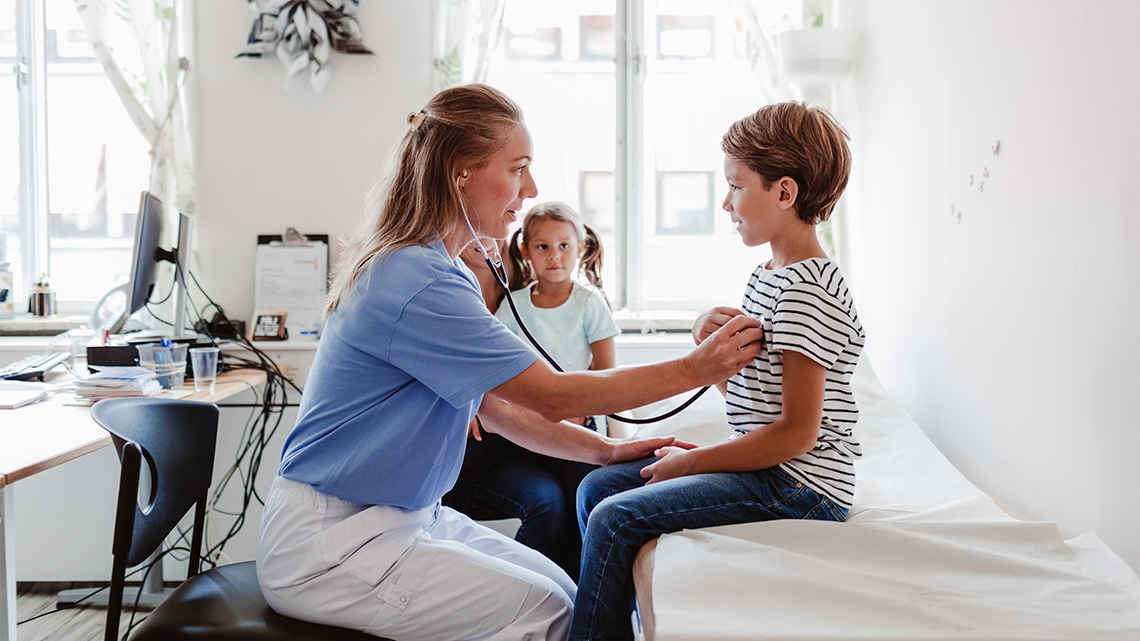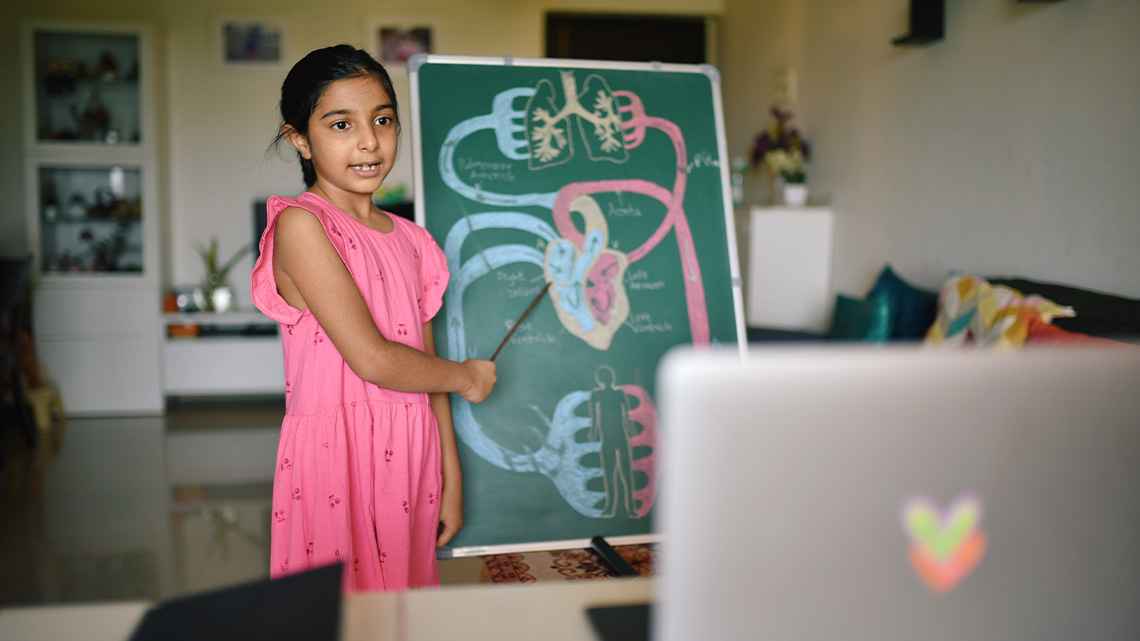Minds On
A focus on systems
Consider the following body systems.
 Description
Description
A kid standing. There are several blocks of text with arrows pointing to different parts of the body.
Part 1: The nervous system sends signals to different parts of the body. Example: brain.
Then there is an arrow pointing to the head.
Part 2: The cardiovascular system delivers nutrients to the body. Example: heart.
Then there is an arrow pointing to the heart.
Part 3: The respiratory system uses organs to breathe in oxygen and breathe out carbon dioxide. Example: mouth.
Then there is an arrow pointing to the mouth.
Part 4: The musculoskeletal system provides support and movement for the body. Example: joints.
Then there is an arrow pointing at the knee.
Can you think of a disease or disorder that may be linked to any of these systems?
Record your ideas in a method of your choice.
Action
Taking control of health

Good health does require some learning, planning and action. For a person to take control of their health, they often consider how exercise and good nutrition can impact their well-being.
What systems would need to be in good health to participate in activities such as swimming?
Swimming works the cardiovascular system, the respiratory system, as well as the musculoskeletal system.
All of these systems work together for the action of swimming, and their efficiency improves with more practice as a swimmer.
Task 1: All systems go!
When people visit the doctor, the doctor is gathering information about their health and well-being. Some examples include a person’s growth, healthy habits, and maybe investigating for any type of disease.
Doctors understand the links between the body’s systems.
Let’s explore some of the body’s systems and the parts of the body that work together as a part of that system.
Image 1: This image of the cardiovascular system highlights the veins, capillaries and arteries that travel throughout the body from head to toe, including the arms and legs. These are represented as long red and blue tubes. The heart is also shown in this image and the veins and arteries that extend from the heart.
Image 2: This image of the nervous system highlights the brain, spinal cord travelling down the back, nerves which are represented as threads travelling throughout the body from head to toe, including arms and hands. The brain is represented as a large oval shaped object at the top half of the head.
Image 3: This image of the respiratory system highlights the nose and mouth area of the head, the nasal cavity and trachea which is a tube connecting the nose and mouth highlights to the two lungs which are oval shaped objects in the chest area of the body.
Image 4: This image of the digestive system highlights the mouth area as a circle, then a tubular esophagus running down to the stomach, and tubular shaped small intestines, large intestines.
Image 5: This image of the musculoskeletal system shows a person with half bones, half muscles. The muscle side highlights the muscles as long, thin and thick lines throughout the entire body, from head to toes and hands. The skeletal side highlights the skeleton inside the body. It includes the skull the spinal cord extending from the skull to the pelvis which is two bones at the bottom of the torso. There are bones extending from the chest to the shoulders, then down the arms into the hands and fingers. There are also bones extending from the pelvis down the leg into the feet and toes.
Image 6: The immune system is spread throughout the body. In the throat are tonsils and lymph nodes, just below the armpit is the spleen, which is shaped like a bean. In the hip/stomach area is the appendix which is shaped like a wishbone or a large u. Then in the leg (although it is throughout your body) is the bone marrow which is the spongy inside of most of the bones in the body.
Check your learning!
Let’s try some more!
Feeling symptoms

Sometimes, people go to the doctor because they are not feeling well. They have symptoms of an illness of some kind.
Press ‘Definition’ to access the meaning of the word symptoms.
Symptoms are the signs that something might not be ideal. For example: a headache, a stomachache, a rash are all symptoms of something not going right.
Practice matching the following symptoms that someone might tell their doctor about, with the system that might be experiencing some trouble.
For each symptom, select the corresponding body system.
Case study
As a grade 5 student learning about body systems, for this activity, you will use clues from the information shared to draw some conclusions about what disease or disorder this person may have.
The first person is a junior level student who plays lots of sports. Click the audio button to listen to the student’s symptoms. Use your research process to consider how you will record your learning.
Before you begin your research, explore this video that explains the Scientific Research Process.
Patient #1
The doctor asks: What brings you here today?

Access this audio recording to hear the patient’s answer.
Patient 1
Consider the parts of the body that the patient is discussing and what body systems are linked to those parts of the body.
Select the correct answer, then press ‘Check Answer’ to see how you did.
Did You Know?
Did you know?
Active students who play contact sports have to be careful to protect their heads against concussions. Symptoms of a concussion can be headaches, tiredness, blurry vision, sensitivity to sounds and movement and trouble concentrating.
Patient #2
The doctor asks: What brings you here today?

Access this audio recording to hear the patient’s answer.
Patient 2
Consider the parts of the body that the patient is discussing and what body systems are linked to those parts of the body.
Select the correct answer, then press ‘Check Answer’ to see how you did.
Patient #3
The doctor asks: What brings you here today?

Access this audio recording to hear the patient’s answer.
Patient 3
Consider the parts of the body that the patient is discussing and what body systems are linked to those parts of the body.
Select the correct answer, then press ‘Check Answer’ to see how you did.
Types of conditions
Diabetes

Diabetes is linked to the digestive system. When food is digested, glucose goes into the blood. Glucose is the body’s main source of fuel, and the glucose helps the body stay running. The part of the body called the pancreas makes a hormone. This hormone is called insulin. With this insulin, the body gets the energy it needs.
Diabetes is diagnosed if a body cannot make insulin on its own or struggles to balance insulin in their body.
Explore this video to learn more about diabetes. Record what you have learned using a method of your choice.
There are ways that Ella and her guardian or caregiver can help her with her diabetes.
Here are some things that children and/or their caregivers can do every day to manage their diabetes:
- children can take control of their health by noticing when they don’t feel well and telling an adult
- testing their blood sugar
- children can find a balance of food and exercise
- putting insulin into their bodies
Autoimmune disease
If someone has an autoimmune disease, their body cannot fight against virus, bacteria or parasites that enter the body. Many of these diseases can affect more than one part of the body.
Explore the following video called “The Sock Project” to learn more about autoimmune diseases.
How was autoimmune disease explained in the video?
How can the Sock Project help people with autoimmune disease?
Record your answer in a method of your choice.
Consolidation
Check your learning

Use the information shared about different body systems to answer these true/false questions. For any false answer, record information that would make that statement true.
Select the correct answer, then press ‘Check Answer’ to see how you did.
Think about it!
Use your learning to answer the following reflection questions in a method of your choice.
- What are three pieces of information that you learned that you would like to share with someone else? Why?
- What is one connection you can make to the information discussed in this learning activity?
- What is one way that body systems are connected?
- What is one piece of information discussed in this learning activity that surprised you? Why?
Reflection
As you read through these descriptions, which sentence best describes how you are feeling about your understanding of this learning activity? Press the button that is beside this sentence.
I feel…
Now, record your ideas using a voice recorder, speech-to-text, or writing tool.





